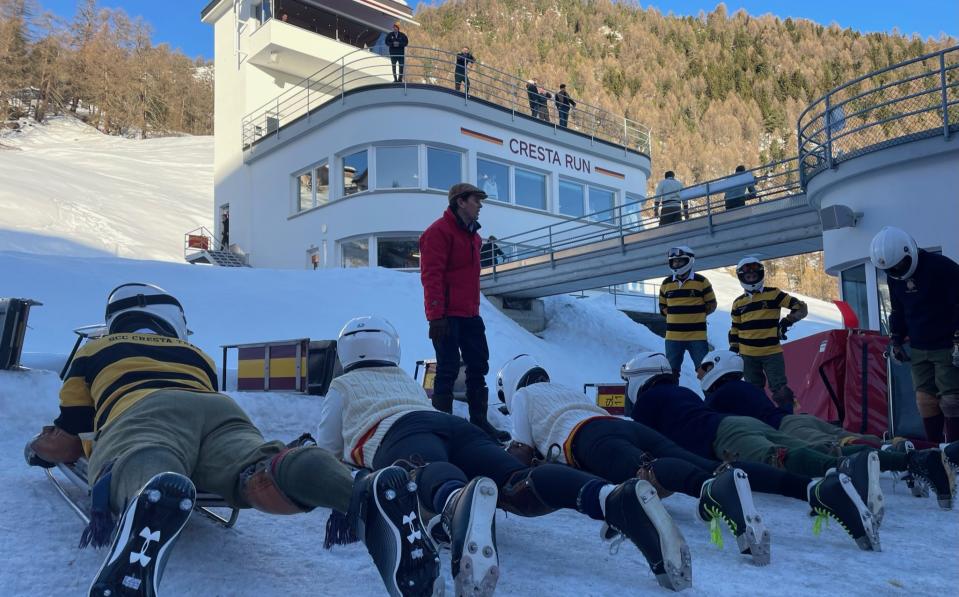The thrills and terror of Cresta Run – by the women who have taken on the skeleton track

Carina Evans knows how to take a fall – but she has never fallen like this. Losing control of her racing toboggan, she flies head-first into a barrier, spins and careers down the outer wall. Her body is thrown back into the track to pinball off its sheer sides and when she does finally stop, the crowd are screaming at her to move. A 100lb sled is chasing her down on wicked blades: she curls into a ball as it slices past her.
“A hell of a smash,” is Evans’s description as she recuperates two days later. She has escaped one of the Cresta Run’s most spectacular crashes of modern times without breaking a bone. Training for the Ladies’ Grand National, the first to be held on St Moritz’s infamous skeleton course in over a century, she was experimenting with a different approach when she lost control.
“I smashed off the corner before, then I just blanked and flew out,” she says. “I had brilliant protection and a new helmet, which I’m grateful for, but I still don’t know how I walked away.”
Somehow Carina Evans escaped this wipeout without breaking a bone 😳
She became the first woman to descend Switzerland's Cresta Run in 2019 but crashed on this year's course 🛷#TelegraphWomensSport pic.twitter.com/ZavBGODn3u— Telegraph Women’s Sport (@WomensSport) February 14, 2024
For over a century, the three-quarter-mile Cresta Run, which drops 514 feet, and is built from scratch each year, was deemed too dangerous for women. St Moritz Tobogganing Club’s ban on female riders, instituted in 1929, was overturned only six years ago. Evans grew up at this course – her father, Digby Willoughby, ran the club for 24 years – but until 2018 she was only ever allowed on its lower banks, and that on the very last day of the season, when the ice was slushy and slow.
Having waited a lifetime to compete on equal terms, even Evans had qualms. “Looking back, it seems totally utterly ridiculous to say this, but we didn’t know if women could do it.”
Just a month in, this season is already one of high emotion, unprecedented drama, and a barrage of female firsts. In January, Barbara Hosch became the first woman to be awarded club colours when she won the Lorna Robertson Cup, an achievement as poignant as it was extraordinary: she was at her father’s funeral just 24 hours before the tournament. “I can perform better,” Hosch reflects, two weeks on. “But it was quite good considering the circumstances.”

Her father, a Cresta rider and a doctor, used to administer first aid after accidents on the track and created the composite of X-rays – a skeleton with a broken neck and a shattered pelvis, among other gruesome injuries – that the club still uses to warn beginners of its hazards. Barred from joining him by the club rule, Hosch turned to bob skeleton and has represented Switzerland in two World Cups. Yet even as an international athlete, she had experienced nothing like the intensity of the Cresta Run.
“It’s like cross-country skiing and skiing. Just because you’re wearing skis, it’s not the same sport,” Hosch says. “On the bob, you lay still the whole way down – here you have to move and steer hard.” The fear factor is also higher. “I was never scared on bob. But here I’m still struggling, I still don’t feel at ease, I’m nervous every time I’m up there. You can’t see where you’re going – the run just sucks you in and pulls you down.”
The full course is so extreme that riders must qualify to ride it by posting consistently fast times on the lower banks and passing a “raking exam” that proves they can execute a dead stop at speed. It usually takes multiple seasons to make it to “Top” and only 13 women have done so since the lifting of the ban.

But even riding from “Junction” – the halfway point where newcomers begin – requires nerves of titanium. This month, a group of MCC cricketers made history as the first all-female team to compete the Inter Club Challenge – a handicapped, invitational event in which beginners race against riders with years (or decades) of experience. “Just standing and waiting to go down first time is terrifying,” Amanda Pearce Higgins says, “because even though you’ve had instruction, you still have no idea what to expect.
“It’s pure terror. At the end of my first run all I could think was, ‘What the hell just happened to me?’” The team had taken on the challenge to raise money for the MCC Foundation, whose projects support girls’ cricket both in the UK and abroad. They also wanted to break gender barriers in sport, which made it all the sweeter when Pearce Higgins placed fifth – out of a field of 68 – in the individual rankings.
Among those cheering them on was Bella Evans, the 18-year-old daughter of Carina, who was that week pursuing her own ambition to ride from Top. She had failed her first raking test, then witnessed her mother’s dramatic crash from the control tower where she works. Two days later she achieved her goal: Bella and Carina are only the second mother-and-daughter Cresta Riders in history.
“Even the beginners are going at 50mph, and they’re inches off the ice,” Bella says. “From Top, you’re going at 70mph. I live in the countryside – I rarely do that in my car.” A proud Carina is delighted by the young generation emerging to challenge for honours on the Run: her main advice to her daughter is to enjoy herself. “And if you don’t enjoy going fast, you’re not going to enjoy Cresta.

 Yahoo Sport
Yahoo Sport 



































































